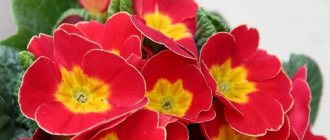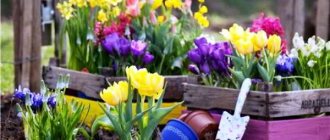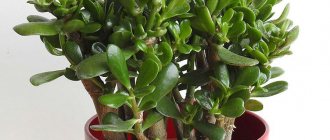Bulbs are the first to greet the beginning of spring. They bloom already in April, when perennials are just awakening from winter hibernation. Therefore, in every flower garden there is at least a couple of bulbous primroses, enlivening the dull landscape of flower beds and giving a spring mood. Of course, you want maximum brightness and abundant flowering for a long time, but this depends on the correct selection of varieties. Some bulbous perennials have a very short flowering phase and disappear quickly. Others cannot stand the excess of May rains; large inflorescences get wet and break, so they also don’t achieve any special aesthetics. Therefore, when purchasing bulbs, you need to pay attention to the flowering period of the variety, resistance to weather conditions prevailing in your area, and ease of care.
- 2 Best bulbous flowers for the garden based on ease of care
- 3 Plants that require special living conditions
- 4 Solo flowers: who is good at single plantings?
- 5 Decorative onions (alliums): beautiful in group plantings
- 6 Spectacular and unpretentious new items
6.1 Glamini: an alternative to regular gladioli
- 6.2 Montbrecia: gladiolus from Japan
Flowering period: the longer the better
Since bulbous plants are grown solely for the beauty of their inflorescences, I want to extend this phase longer. And this is possible if the plants are planted correctly. Many varieties accelerate the flowering period if they grow in the sunny side and, conversely, slow down the wilting process when they are in the shade. Tulips, crocuses, gladioli and lilies exhibit such properties especially strongly. Therefore, they should not be planted in areas where it is sunny all day. It is better that in the first half of the day (when the sun is especially hot) these plants are in partial shade.
In addition, different plants differ in the duration of flowering. For example, the variegated tigridia produces one inflorescence from each bulb in the summer, which lives only 8 hours, after which it immediately withers. So summer residents who come to the site only on weekends may not see this happy moment at all. True, if you plant a group of tigridias, they will not all bloom at once, but this does not change the overall picture much.
Tigridia looks great in group plantings, but each flower lives only 8 hours, after which it immediately fades
The flower shoots of the bird's eye grow gradually, making their way among the thin long leaves, so the plant pleases with beautiful flowers for about a month
The most “long-lasting” spring bulbous flowers include:
- anemone (blooms for about 3 weeks);
- royal hazel grouse (2-3 weeks of flowering);
- tulip (keeps flowers for up to 3 weeks depending on location);
- daffodil (blooms for more than 10 days).
Summer “long-livers” in terms of flowering are considered to be poultry plants, freesia, and some varieties of lilies.
When planting freesias, be prepared that they will require careful care:
Game of colors
The selection of colors depends on the appearance of the house.
Colors come in warm and cool colors. To obtain contrasting combinations, you should combine cold and warm shades. To achieve harmony, colors that are similar in tone are used. Almost every garden uses white colors.
You should use the same color scheme in every corner of the garden to avoid oversaturation.
The basic rule is to use no more than 3 shades. There is one more nuance - harmony is achieved with a color ratio of 70:15:15.
The best bulbous flowers for the garden based on ease of care
The second criterion for choosing bulbous plants, which is used by “lazy” summer residents, is the degree of care for the plants. The less hassle you have to deal with them, the more profitable it is to grow them.
Many bulbous plants require annual digging after the above-ground parts die off. If this is not done, then the bulbs will become smaller until they disappear or even freeze out in the winter. Such demanding “beauties” include varietal tulips (especially unusual colors, parrot and lily), gladioli, freesia, and hyacinths. So if you don’t want to dig them up, dry them and create conditions for storage, you’ll have to make do with less demanding varieties.
Hyacinth can also be grown in a pot, read about it:
The unusual beauty of parrot varieties of tulips requires special conditions for their growth: annual digging, proper storage and several feedings
Thus, lilies, daffodils, crocuses, all types of decorative onions, anemones, crocosmias, royal hazel grouse, and muscari successfully grow in one place for 3-4 years.
Muscari, or mouse pea, is very unpretentious, grows in one place for several years and quickly reproduces by dividing bulbs and seeds
Landing rules
Before planting, the soil should be thoroughly dug up and organic or mineral fertilizer applied. The composition of the soil should also be taken into account; if it is too acidic, liming is performed. Sand is then added and the soil is allowed to settle for a couple of days.
It is important to respect the planting deadlines! Spring garden flowers are planted from September to early October, summer flowers - in the spring.
The hole should be 2-3 times larger than the onion. The bottom is covered with river sand.
Plants that require special living conditions
In pursuit of growing large inflorescences, breeders do not always take into account the degree of stem thickness. And many new bulb varieties have huge flowers but thin stems. This, of course, looks gorgeous in a flowerbed when the weather is warm and calm. But if during the flowering season there is a rainy season or a strong wind rises, all the beauty will instantly fall to the ground, because the thin stem will not withstand the swinging or the wet, heavy inflorescence. This situation can occur with many varieties of double daffodils and freesias.
Recent Entries
Lilac perennials that are beautiful, compact and do not crowd out other plants Why when buying seedlings you should not take the sellers’ word for it and how to determine the age of the plant using 3 signs Tomato seedlings have turned purple or whitish: why the color has changed and how to save the plants
The more petals in the inflorescence of a double narcissus, the faster it gets wet and puts its weight on the thin flower arrow
Gladioli often break, but not because the stem is weak. On the contrary, a powerful flower arrow with an abundance of large inflorescences becomes a heavy burden for the bulb. And it is at the point where the stem begins to grow that breaking occurs during windy weather. Therefore, many plants with tall stems will have to be tied up as soon as flower stalks begin to appear. You can, of course, immediately plant bulbous plants near a net or fence, but such a place is not available in every area. By the way, a very close “relative” of the gladiolus – acidanthera – is absolutely not afraid of the winds. However, only one flower produces.
Tulips
Following the daffodils, we wait for the tulips to bloom. Mine have already formed buds.
I like it when there are a lot of them and they glow with scarlet colors.
In general, of course, not only red tulips look interesting. I grew up with a lot of these colorful ones. The yellow flowers are very beautiful, and I especially love my white ones with a double edge, and of course the others that I’m trying to breed.
I have already written in more detail about spring flowers, tulips, you can also look at my photos there.
I usually feel sorry for cutting flowers in the garden. But there are so many tulips that you can still make beautiful spring compositions for the holiday. Just in time for Easter, there will still be flowers and you can decorate the festive table with them in an original way.
Solo flowers: who is good at single plantings?
When decorating flower beds, bulbous plants can act both as soloists, thanks to their high growth and large inflorescences, and as a background. Gladioli, some varieties of lilies, acidanthera, and crocosmia are considered the tallest. But if the lily is good in a single planting, then it is better to plant the rest in a small group, because their peduncle is narrow and bare before the inflorescences begin.
Not every flower in the garden can compete with the beauty of lilies and their high growth, which is why they are given the best places in flower beds
Royal hazel grouse look good in the center of flower beds. True, choosing a background for them is quite difficult. These bulbs are among the first to bloom. But among conifers, creeping perennials, climbing plants and decorative onions, they look truly royal. And if you plant it in a group with a lily, then while it gains strength and growth, the hazel grouse will have time to bloom and generally disappear, giving way to its followers.
Article on the topic: Planting bulbous flowers in autumn: general rules + review of the best 6 varieties
Rules for choosing plants
- Noble tulip varieties will be an excellent option for regular-style gardens. Garden varieties of daffodil, hazel grouse, hyacinth, and lily look great in flower beds and rural gardens. They require nutritious soil and sufficient sun.
- In small gardens and alpine hills, miniature forms of flowers should be planted. You can give preference to wild daffodils and tulips. They look no less attractive than their garden counterparts. A number of varieties grow without care and run wild near bushes and trees.
- Those dreaming of a lawn where bulbs will bloom in the spring should know that mowing the grass will only be possible from the beginning of June. Daffodils, photos of which you can see in detail, cannot be mowed within 8 weeks after flowering, otherwise they will not be able to bloom next year.
- Crocuses, which, like snowdrops, are primroses, fade most quickly.
- The first spring bloom looks most impressive in a shady garden. Anemones, chionidoxas, corydalis, and spring flowers are blooming. It is noteworthy that the presented species do not require care. After the flowers die, plant life continues in the bulb. Next spring, beautiful buds will appear again.
Decorative onions (alliums): beautiful in group plantings
A large group of bulbous plants for the garden are decorative onions. Over 150 varieties of them have been selected, but for some reason alliums are used much less often than tulips or gladioli in the design of flower beds. But in vain! These plants have very compact tubular leaves that form a bush, and the number of flowers on one plant reaches 60 pieces. Decorative onions have a long growing season, so they will be beautiful all spring and summer, even if the flowering period has not yet arrived. Varieties differ in flowering time. Early onions begin to bloom by mid-May, and late ones - at the end of August, and the flowering duration is a month or more.
These bulbs are good for decorating the edge of the border, the lower tiers in multi-stage flower beds, and including in mixborders. And, for example, the chives variety can also be eaten. In spring, its thin tubes emerge from the ground very early, ahead of even winter onions, so you will get double pleasure - both aesthetic and nutritional.
The chives, whose feathers you did not have time to eat in early spring, will produce beautiful lilac balls-inflorescences by summer, decorating a garden bed or flowerbed.
Spring bulbous perennials
Spring bulbous perennials are filled with special tenderness. They are the ones who attract the attention of passers-by, blooming in early spring, when almost all of nature has not yet awakened from sleep.
Tulip
Bulbous perennials, native to Asia, bloom in early May, although there may be some factors that change the timing of flowering (climatic conditions of the region, amount of moisture, etc.). The species differ not only in color, but also in height (from 10 cm to a meter).
There are several colors of tulips that can be seen in the photo:
Narcissus
Another common representative of bulbous perennials is the narcissus, which is represented by 60 species. However, in the middle zone, just over 25 varieties of this flower are grown. Flowering can begin in mid-April, but not later than early May.
Types of daffodils:
- Tubular;
Important! This variety is considered the most popular and widespread among gardeners. It does not require special care, is resistant to spring frosts, and does not require fertilizing or frequent watering.
- Large-crowned;
- Small-rooted;
- Terry;
- Triandrus;
- Cyclamenoid;
- Jonquilliaceae;
- Poetic.
In addition to these species, there are many more hybrids, some of which are not even included in the State Register of the Russian Federation.
Grouse
Fritillaria, or fritillary, is also a bulbous perennial flower that blooms in the spring. The flowers got their name because of their appearance and color. The plant can also be compared to a palm tree, the top of which is decorated with original buds. Popular names for hazel grouse are tree of paradise, which has about 150 species.
The most popular varieties:
Grouse can bloom for a month, but it all depends on how much sunlight they receive. Therefore, it is best to plant this perennial in lighted areas.
Attention! The brighter the light, the more saturated the colors of the buds will be.
Crocus
Saffron, or crocus, has more than 300 varieties, most of which bloom in autumn. But there are also early varieties that bloom their buds even when all the snow has not yet melted. Bulbous crocus is not afraid of frost and precipitation in the form of snow, therefore it is a permanent resident of many flower beds.
Among the most common types of this perennial are:
- Spring;
- Two-flowered;
- Golden;
- Tomasini.
Chionodoxa
This is a perennial, low-growing bulbous plant of which only 6 species are found. It got its name from two Greek words - snow and pride. Popularly it has its own name - “snow beauty”, or “snowman”. The flowering of the crop begins very early, at the moment when snowdrops make their way through the thawed patches.
- Chionodoxa Forbes;
- Sardinian;
- Chionodoxa Lucilia (giant).
The plant does not like to grow with other bulbous perennials, so it should be planted away from them. But the proximity to weeds and other plants does not bring him discomfort. In addition, Chionodoxa does not need special care; it is enough to fertilize in the fall; watering is only needed in case of dry weather.
Important! Protection from pests is also not required for the crop.
Spectacular and unpretentious new items
The bulbous plants that inhabit most flower beds are known to everyone: tulips, lilies, gladioli, daffodils, snowdrops. But names such as glamini or montbretia are known only to lovers of exotic bulbs. We do not buy new items, fearing the difficulties of care, although there are no special problems with these plants.
Glamini: an alternative to regular gladioli
The term “glamini” refers to miniature gladioli, the height of which does not exceed half a meter. They bloom much earlier and, unlike their giant “brothers,” do not bend or bend from the wind. Such varieties are grown both in open ground and on balconies. The only negative is the annual digging for the winter and storage in the refrigerator.
Glamini has no fewer colors and varieties than ordinary gladioli, and they tolerate windy weather and rain much better
Rules for caring for them
In general, bulbous plants like well-drained soil, although some plants can grow in heavy loamy soils.
The planting depth of the bulb largely depends on the plant. Small bulbs (galanthus, crocus, narcissus, muscari) are planted closer to the surface (to a depth of 5 - 10 cm), large bulbs (narcissus, tulip, hazel grouse) are buried deeper (15 - 20 cm).
ON A NOTE . Determining the planting depth is easy. It should be 3 times the size of the bulb itself.
Choose a sunny place for planting, protected from drafts. You can arrange the flower bed in such a way that at noon the plants are protected from the scorching sun by the trees. But it is important to consider that in the shade, bulbous plants become smaller and bloom poorly.
In care, bulbous flowers love moderation. There is no need to flood the plants and apply a lot of fertilizers. By the way, it is better to use mineral supplements.
It is very important to weed, as flowers do not like being close to weeds.
Bulbs are resistant to pests, and among diseases they are mainly susceptible to fungal diseases. But, if you carry out regular preventive treatments with fungicides and do not pour too much water, then there will be no special problems with growing flowers.
Some bulbous plants (for example, gladioli) need to be dug up for the winter, but most of the representatives of this flower group are frost-resistant plants and can overwinter in the soil.
But to do this, you need to provide them with reliable shelter for the winter. Peat, fallen leaves and dry grass are quite suitable. You can first lay spunbond directly on the ground. The covering layer should be about 8 - 10 cm.
Plants need to be covered at the first frost. There is no need to do this before, as the flowers may begin to sprout. The shelter is removed in the spring, when it is completely warm and there are no morning frosts.
General care rules and important tips
In the paragraph above, we talked about bulbous flowers at home, showed photos and names, and also provided a brief summary of caring for them. However, there are a number of general rules and tips for all bulbous plants. And every novice amateur gardener should know about them.
- Simple but reliable methods. There are a number of whims common to all bulbous plants: love of moisture, love of light, dislike of acidic soil. Also, bulbs often become a tasty morsel for various beetles, mites, fungi, and other parasites. In order not to run around the shops and look for poison (which can also destroy the flower), you can use traditional methods proven by experience. Crushed eggshells and wood ash help reduce soil acidity. To prevent diseases: the same wood ash or ground charcoal.
- Diseases. Even if you decide to get an unpretentious plant from the bulbous family, your pet always has a chance to catch some kind of parasite. We advise all beginning gardeners to regularly inspect the leaves and other parts of their plants. If various unnatural spots, yellowness, or signs of rotting occur, it is necessary to find out the cause and either try to cure the flower or destroy all parts to avoid infection of the entire flower garden.
- Care. And the most important advice is just don’t forget about the living organism that you have tamed and have taken upon yourself to protect it from various diseases and help it grow. In this case, your flower will repay you with the beauty of its bloom and will delight the eye and create a wonderful atmosphere in your home!
Today we found out what kind of home bulbous flower can be planted, we saw photos and names of many exotic bulbous plants. You can find even more information about flowers, planting, soil care, as well as many ideas and drawings of useful homemade products in our garden section. Take care of your “green pets” and enjoy their beautiful blooms every season!
Features of bulbous indoor plants
Plants that are commonly called bulbous plants are quite diverse, but they all have a bulb, which they need to accumulate nutrients. The leaves extend from the bulb and form a rosette.
Important! For normal growth and flowering they need diffused light.
Most bulbous plants have a clearly defined dormant period. At this time, they shed all their foliage for a while. Some flowers that form a thickened root system retain their foliage throughout the year, but there are very few of them.
Like most indoor flowers, bulbous flowers do not tolerate frost. When the foliage dies, the bulb remains in the flowerpot. During this period, plants are practically not watered and fertilizers are completely excluded. But some flowers, such as cannas, require completely different care in winter. Indoor varieties have perennial bulbs that form more and more flower stalks every year.
You may be interested in: Preserving tulip bulbs to expel them by March 8 On March 8, there are two most popular flowers that are given to women - these are, of course, mimosa and tulips. If...Read more...
Blooms in late spring
The most popular spring garden flowers are perennial bulbous ones that bloom closer to summer:
- decorative onion - very original in appearance, it must be planted in a sunny place and so that there are no gusts of wind;
- summer white flower garden - white violet, begins to bloom at the end of May.
Video “Forcing technology”
From the video you will learn how to force house plants.
Bulbous indoor flowers will be a worthy addition to any green collection. But simply purchasing a plant is not enough. You need to know how much watering it needs, how to provide it with optimal lighting, etc. Quite often, novice gardeners can confuse related bulbous plants with each other.
For example, there is an opinion that amarylis is another name for the well-known hippeastrum. In fact, there is very little in common between them; in appearance they somewhat resemble each other, but in all other respects they are completely different indoor flowers.
Amaryllis constantly forms daughter bulbs near itself. The flowers of the plant have very bright, varied shades. Amaryllis blooms once a year, but with proper care you will certainly prolong this process.
House flowers in which the root system is represented by a bulb include wallot. This perennial plant will be part of your home green island for a long time. This flower is characterized by a long peduncle, the flowers on which are collected in an umbrella. The leaves are long, green with iridescence. Vallota produces red buds. As for the number of peduncles, at the early stage of flower development there is usually only one. But over time, when the bulbous roots get stronger and grow, a pair of such stems may appear from them at once. Caring for wallot is not difficult. The main thing is to protect the flower from direct sunlight; it is better to provide it with access to diffused light.
The flower representatives of bulbous plants also include fragrant hyacinth. It can take root well in the garden, but flower growers often purchase several bright specimens exclusively as house flowers. What is so special about hyacinth? First of all, its flowering, which lasts from December to March
It doesn’t matter how long ago you planted the plant in the pot. If the bulbs are still small, they will produce only one flower stalk, but the colorful flowers on them may not fade for up to three weeks.
Some of them are distinguished by the presence of rather small flowers, but they produce more than one peduncle, so such a plant will not take the last place in your personal rating of indoor pets.
Do you want your home or apartment to be filled with an amazing, intoxicating aroma during the cold winter? In this case, you cannot do without purchasing freesia. This is a low plant that can reach 30-40 cm in height.
What else is remarkable about freesia is its variety of shades. Your windowsill may be filled with a flower specimen in white, red, pink, yellow, orange and even burgundy shades.
Forcing bulbous plants at home is quite possible if everything is done correctly. Moreover, not only those that we are accustomed to consider as such can serve as indoor flowers. For example, who would have thought that the same daffodils, the harbingers of spring, can be easily grown both as garden and house flowers. In addition, this group includes several different species that take root well indoors.
Hippeastrum
This amazing plant has gained wide popularity among experienced gardeners. In addition, the flower looks very beautiful, especially when the buds bloom. In its appearance, hippeastrum is in no way inferior to even orchids. In addition, the variety of its colors and shapes of flower petals will allow you to collect a real flower collection on your windowsill. Hippeastrum buds bloom several times a year. However, the frequency and duration of flowering largely depends on the quality of plant care.
Despite the fact that this plant belongs to the bulbous group, its root system is more tuberous than represented by bulbs. Indoor gloriosa can give your interior some zest. This flower has long stems that resemble a vine.
By properly directing the plant, you can decorate your home. And everything would be fine, but the gloriosa tuber can cause serious damage to your health if you did not adhere to basic safety measures during the process of transplanting the plant.
The species diversity of this plant includes hundreds of different specimens, and many of them are consistently grown by gardeners at home.
Crocuses bloom not only in spring, but also in autumn: it all depends on their varieties. Their inflorescences are attractive and fragrant, so they will be a wonderful decoration for any indoor living island. Crocus does not require particularly delicate care; feeding will only be needed during the period of active development and flowering itself.
Useful tips and tricks
If you are determined to start growing tuberous or bulbous flowers at home, then you should take on board some useful tips and recommendations for their care and maintenance.
To plant bulbous indoor flowers, only good clay pots with thin walls are suitable. With the onset of the plant's dormant period, it will be necessary to either reduce watering or stop it altogether. When the planting is in an active stage of growth, on the contrary, it must be watered regularly. A high level of humidity has to be addressed when it comes to forcing flowers in a greenhouse. When watering indoor plants of the types considered, it is recommended to use the bottom watering method. In this way, it will be possible to avoid unnecessary waterlogging of the soil and rotting of the bulbs. In both the case of bulbous and tuberous flowers, one must not forget about the drainage layer in the pot where they will be planted. Some indoor plants, such as the bulbous perennial Weltheimia, are susceptible to fungal diseases. These are serious illnesses that can affect a flower and its “neighbors”. Plantings with such problems require only moderate watering. Overwatering can be dangerous. Always keep your green pets' health under control
If you notice that your potted plants don't look good and are clearly sick, there's no time to waste. It is necessary to determine as soon as possible what the cause of the problems that have arisen is, and then begin to solve them.
It can be very difficult for a novice gardener to understand what contributed to the development of a particular disease, so in case of doubts or questions, it is better to consult with a more experienced person who is well versed in such issues.
Sources
- https://ogorod-bez-hlopot.ru/lukovicnye-komnatnye-rastenia.html
- https://yan-dir.ru/lukovichnye-komnatnye-rasteniya.html
- https://doma-v-sadu.ru/komnatnye-rasteniya/lukovichnye.html
- https://agronomva.ru/lukovichnye-komnatnye-rasteniya/
- https://stroy-podskazka.ru/komnatnye-cvety/lukovichnye-i-klubnevye/
- https://podokonnik.temadnya.com/1476104878896973943/lukovichnye-komnatnye-tsvety-s-nazvaniyami-i-foto/











